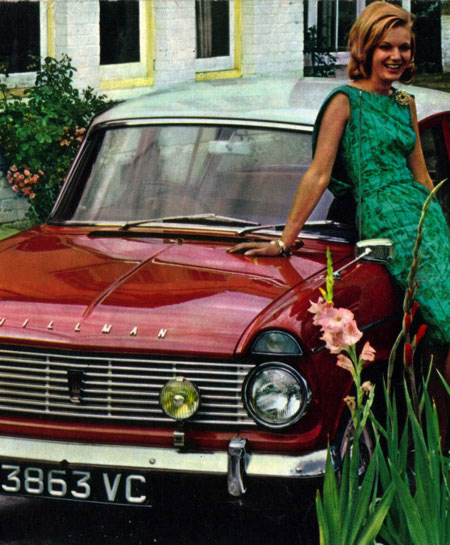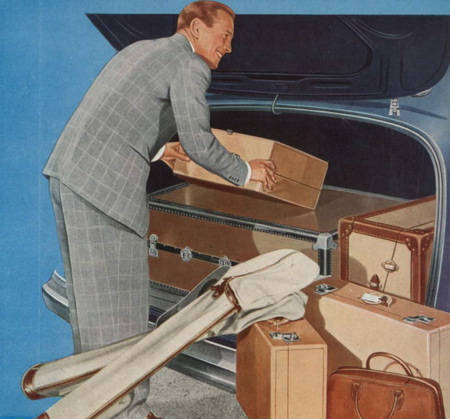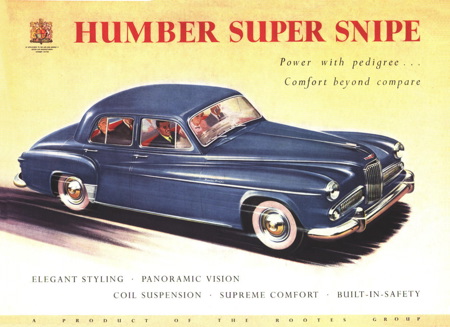Scanning Around With Gene: Where the Steering Wheel is on the Wrong Side
I’ve never owned a British car, though I’ve been attracted to a few and came close to buying an MG sports car when I was a teenager. But, fairly or not, I’ve let the questionable reputation of British vehicles influence me and have stayed away.
I have no idea whether British cars are any better or worse than many others, and I suppose, just as with American cars, you shouldn’t lump all the brands into one mechanical stereotype. Today’s images are from brochures for the Rootes Group of car companies (Hillman, Sunbeam, Humber, Singer, and Commer, among others). Click on any image for a larger version.


British electrical systems are supposed to be particularly bad; Jaguar owners will tell you about tearing their hair out over some electrical short.


Yet even the more working-class brands, like many of those pictured here, have a styling that seems distinctly British and makes you want to look the other way when it comes to mechanical reliability.



Rootes was a little like General Motors: an aggregator of car brands to serve different markets. Hillman was the basic brand, Singer a little more upscale, with Sunbeam as the sports car brand, Humber as a luxury brand, and Commer selling trucks, or “lorries” as they’re called over there.


At one point the company had factories all over England. During World War II, it turned its efforts to airplanes and military vehicles.


A neighbor of mine had a Hillman Husky when I was growing up, and our mailman had a Sunbeam Alpine (which was one of the few Rootes cars to achieve moderate success in the United States).


Many of the earlier brochures used illustrations instead of photography to promote the vehicles. You don’t see many auto illustrations in advertising these days.


And while I know many car interiors where much larger back then, I guess one of the keys to using illustrations was to make them look even more expansive than they were.



There are plenty of reasons to expect British cars to be marketed in ways similar to American vehicles, save for the steering wheel being on the opposite side. Cars are the key to a happy and satisfying life on either side of the pond.


Another striking feature revealed by older car brochures is the what-now-seems-shocking lack of basic safety features. Dashboards were hard metal, seat belts were nonexistent, and things like collapsible steering columns hadn’t been invented.


America’s Chrysler Corporation purchased Rootes in 1967 and the various brands lasted a short while before either being sold again or put out of business. They join a host of other British car marks that are now only collectibles.


There are still quite a few automobile lines made in Britain, including Vauxhall, Jaguar, Rover, and Rolls Royce. I just don’t know if they’ve ever solved their electrical problems.


Follow Gene on Twitter: https://twitter.com/SAWG


Another era of cars! ;)
Rover doesn’t exist anymore. Brit cars were no more or less reliable or prone to rust than American cars…AMC Gremlin anyone? at least ours didn’t explode…
Did you reveal a window to your psyche when you referred to the Humber as a “Humbler”?
With Smith’s Instruments and Lucas electrics, no self respecting British car had a chance in hell to to avoid breakdowns and other inconveniences. That said, the long past, ten year romance with my Austin-Healey and MG still stirs each Spring when rag-top lust sets in.
Yes, please, I WOULD like a larger version! I click, I get a “Page not Found”. Please fix! Gene’s finds are too awesome to NOT see the big scan!
Thanks for the head’s up!
Terri Stone
Editor in Chief, CreativePro.com
I just recently read the memoir of writer/illustrator Bruce McCall. He spent the early part of his adult life in an art studio that worked exclusively for car companies in Detroit. He explains the reason illustration was preferred: It let the car makers lie about the appearance of the car. Typically, they were made to look longer and lower to the ground. When auto makers started making cars that actually looked longer and lower, illustration was out, photography was in, and a lot of illustration studios went out of business.
There’s an entire automotive (and motorcycle, too) subculture related to ‘Lucas, the Prince of Darkness’.
Lucas Industries is/was the main supplier of electrical parts and sub-assemblies for many British motorcars and has (in my experience) a well-deserved reputation for being unreliable.
It has been said that the only Lucas Electric device that didn’t suck was their short-lived home vacuum cleaner. 8-P
…I get to see what a Humber Super Snipe looked like. As a teenager in 1960, my wife saw one on the San Francisco Bay Bridge, but never again, though every now and then when the name comes up we have a chuckle about it.
Thanks, Gene! This is rare stuff.
Sadly, Rover is no longer produced in England. They were bought by a Chinese company and are now marketed only in China as “Rov-ahs” as they did not purchase the name.
I have a soft spot for the sunbeams. The Alpine was the first car James Bond is seen driving on the screen in Dr. No. A friend in high school had a Tiger. It’s the same as the Alpine but it has a Ford V8 in it and goes like stink.
Is this column meant to be “tongue-in-cheek” or do I detect a touch (just a touch mind you!!!) of extreme pro-Americanism here? Or am I just imagining things?
In reality some of the comments have absolutely no justification and are not based on any facts at all, just heresay.
Just a few examples from the article:
“The British are somewhat notorious for making attractive but unreliable cars.” or,
“questionable reputation of British vehicles influence me” or,
“I have no idea whether British cars are any better or worse than many others, and I suppose, just as with American cars, you shouldn’t lump all the brands into one mechanical stereotype.” or,
“British electrical systems are supposed to be particularly bad; Jaguar owners will tell you about tearing their hair out over some electrical short.”
May I ask: “Says who?”
I have no “axe to grind” – I am from Australia!!
…for a “Report Comment” option to be added, as it seems the spammers have discovered CreativePro. It was a wonderful decade plus run, but unless you intend to manually police the comments on a daily basis it would behoove you to allow your readers to help out.
As I’ve noted for more than 11 years now, I love the site… and I especially love Gene’s glimpses of art & lifestyles past.
Let’s keep it clean around here!
– – – – – – – – – – – – – – – – – – –
Sanity is a relative concept.
If you don’t believe me,
let me introduce my relatives.
– – – – – – – – – – – – – – – – – – –